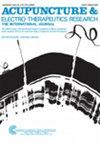Comparative Study of Najia and Nazi Acupunctures to Reduce Rat Gastric Ulcer
IF 0.4
4区 医学
Q4 INTEGRATIVE & COMPLEMENTARY MEDICINE
Acupuncture & Electro-Therapeutics Research
Pub Date : 2020-01-21
DOI:10.3727/036012920x15779969212937
引用次数: 0
Abstract
Gastric ulcer is a common digestive system disease, which leads to the serious decline in the life quality and effective therapies are in urgent need. Midnightmidday ebb flow acupunctures including Najia and Nazi acupunctures have been applied in clinics in China for more than one thousand years and the acupoints are selected according to the time rhythm. Najia acupuncture, namely day-prescription of acupoints, divides ten days (one cycle) into 120 two-hour periods and each period is coordinated with a meridian. Meanwhile, Nazi acupuncture, namely hour-prescription of acupoints, divides a day(one cycle) into 12 two-hour periods and each period is coordinated with a meridian. When there is a disease in a certain meridian, the relevant acupoints are operated in the corresponding time. However, the comparative efficacies of Najia and Nazi acupunctures on promoting the healing of gastric ulcer are still unknown. In this study, gastric ulcer rats were induced by acetic acid and were randomly divided into four groups: non-acupuncture group, normal acupuncture group, Najia acupuncture group and Nazi acupuncture group. After different treatments for continuous 10 days, the gained weight, gastric ulcer area and the thickness of gastric mucosa were measured and analyzed. Decreased ulcer area, increased mucosa thickness and dense scar tissue occurred in the Najia group and Nazi group compared to that in the non-acupuncture group (P<0.05). However, there were no significant differences between Najia and Nazi acupuncture groups (P>0.05). Thickness of gastric mucosa in Nazi acupuncture group increased significantly compared to normal acupuncture group (P<0.05). Therefore, the findings in this study indicated that Najia and Nazi acupunctures had gastroprotective effects and accelerated the healing of acetic acid-induced gastric ulcer in rats, but no significant differences between them. It may provide valuable information for development of acupuncture for the treatment of gastric ulcer in clinics.那甲针与纳粹针减轻大鼠胃溃疡的比较研究
胃溃疡是一种常见的消化系统疾病,导致患者生活质量严重下降,急需有效的治疗方法。Najia和Nazia等午间落潮针法在中国临床应用已有一千多年的历史,穴位的选择是根据时间节律进行的。纳家针,即穴位的日方,将十天(一个周期)分为120个两小时的周期,每个周期与一条经络相协调。同时,纳粹针灸,即穴位的小时处方,将一天(一个周期)分为12个两小时的周期,每个周期与一条经络相协调。当某一经络出现疾病时,相关穴位会在相应的时间进行操作。然而,纳佳和纳粹针灸在促进胃溃疡愈合方面的比较疗效仍然未知。本研究采用醋酸诱导大鼠胃溃疡,随机分为四组:非针刺组、正常针刺组、纳佳针刺组和纳粹针刺组。在连续10天的不同治疗后,测量并分析体重增加、胃溃疡面积和胃黏膜厚度。Najia组和Nazia组与非针刺组相比,溃疡面积减少,粘膜厚度增加,瘢痕组织致密(P0.05)。Nazia针刺组胃粘膜厚度与正常针刺组相比显著增加(P<0.05),本研究结果表明,Najia和Nazia针刺对大鼠醋酸性胃溃疡具有胃保护作用和加速愈合作用,但二者无显著差异。这可能为针灸治疗胃溃疡的临床发展提供有价值的信息。
本文章由计算机程序翻译,如有差异,请以英文原文为准。
求助全文
约1分钟内获得全文
求助全文
来源期刊

Acupuncture & Electro-Therapeutics Research
医学-全科医学与补充医学
CiteScore
0.50
自引率
66.70%
发文量
9
审稿时长
>12 weeks
期刊介绍:
The aim of the journal is to provide an international forum for the exchange of ideas and promotion of basic and clinical research in acupuncture, electro-therapeutics, and related fields. The journal was established in order to make acupuncture and electro-therapeutics a universally acceptable branch of medicine through multidisciplinary research based on scientific disciplines. The final goal is to provide a better understanding of both the beneficial and adverse effects of these treatments in order to supplement or improve existing methods of diagnosis, prognosis, treatment, and prevention of diseases in both Western and Oriental medicine.
 求助内容:
求助内容: 应助结果提醒方式:
应助结果提醒方式:


